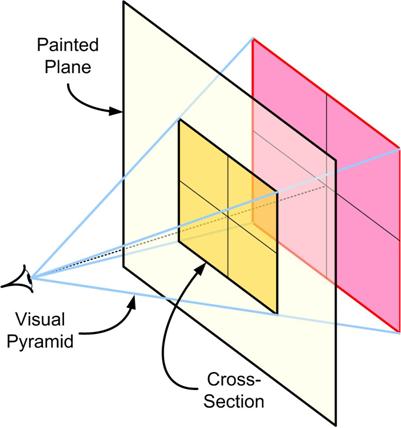 I was reading yet another book on the Scientific Revolution when I came across a discussion of the mathematical significance of the invention of perspective for painting in the 15th century Italian Renaissance. The main player in the saga was Leon Battista Alberti (1404 – 1472) and his tome De Pictura (On Painting) (1435-6), which contained the first mathematical presentation of perspective. Even though mathematics was advertised, it was not at the level of trigonometry I used in my post “The Perspective Map”, but rather entailed simple Euclidean plane geometry. So the discussion was largely historical rather than mathematical. Nevertheless, I became curious to learn how much Alberti was able to discover about perspective without a lot of math. This essay is the result.
I was reading yet another book on the Scientific Revolution when I came across a discussion of the mathematical significance of the invention of perspective for painting in the 15th century Italian Renaissance. The main player in the saga was Leon Battista Alberti (1404 – 1472) and his tome De Pictura (On Painting) (1435-6), which contained the first mathematical presentation of perspective. Even though mathematics was advertised, it was not at the level of trigonometry I used in my post “The Perspective Map”, but rather entailed simple Euclidean plane geometry. So the discussion was largely historical rather than mathematical. Nevertheless, I became curious to learn how much Alberti was able to discover about perspective without a lot of math. This essay is the result.
See Alberti’s Perspective Construction
(Update 7/29/2019) I got a response! Alas, it was from David Wootton, who naturally took exception to my comments about his book:
“It’s quite simply not true that I don’t give a source for my statement about zero. The reference comes at the end of the paragraph because it covers the whole paragraph, and it is to Rotman’s Signifying Nothing: the Semiotics of Zero, first published in 1987.”
Upon review, I confess that my remarks were most intemperate and born of a certain frustration that I vented in my own echo chamber—forgetting that I am overheard. The lack of responses to my postings allowed me to fall into the echo-chamber error I was hoping to avoid. The second error, which I also abhor in book reviewers, was to criticize the book for not including topics that were of interest to the reviewer but not to the author, namely in this case, what was the mathematics alluded to at various junctures in the period under discussion? For example, what was Alberti’s mathematics before the advent of plane trigonometry, symbolic algebra, and analytic geometry which I used to figure out the projection (and similarly for Mercator before logarithms)? But Wootton’s goal was to assume the mathematics and investigate how it affected the times more broadly, in art, architecture, literature, etc. So I offer a chastened apology and hope I can be more measured in my assessments and evaluations.
Regarding the instigating issue “the unattributed claim that zero, as a number or numeral, had an Arabic origin”, Dr. Wootton and I had a surprisingly benevolent exchange on the matter, considering my initial remarks. I explored his Rotman reference, as well as his further suggestions of the Wikipedia article on Zero and Keith Devlin’s book, The Man of Numbers about Leonardo of Pisa (Fibonacci). But alas, all these sources (and others) supported my view of the Indian origin and not the Arabian. So technically the Rotman reference is not a source for the statement at issue, though it may have been for other material in the surrounding paragraph. Nevertheless, given the real purpose of the book and Dr. Wootton’s evident erudition, this slip-up should not taint the rest of his argument, which did provide stimulus for thought.
By the way, I considered my laboring through Rotman’s philosophical ruminations on zero and semiotics to be sufficient punishment for my errors. Rotman was trained as a mathematician, and I had no trouble following any of his mathematical discussions, but when he took flight into the import of “signs” and semiotics, I was lost. I guess it was fair turnabout for those who read mathematics incomprehensibly when I would scan a sentence involving semiotics, recognize all the English words, but understand nothing. I avoided philosophy courses in college for this reason.
